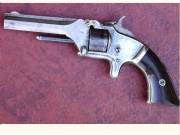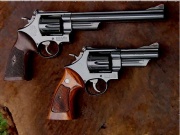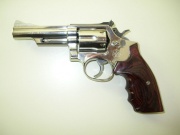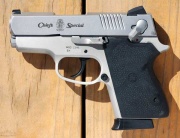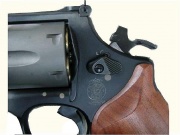Smith & Wesson
| ||||||||||||||||||||||||||
[[Image:|right]]Smith & Wesson NASDAQ: SWHC (S&W) is the largest manufacturer of handguns in the United States. The corporate headquarters is in Springfield, Massachusetts. Smith & Wesson is known for the many types of ammunition it has introduced over the years and for its revolver expertise.
Contents |
[edit] History
[edit] Beginning
In 1852, partners Horace Smith and Daniel B. Wesson formed a company to produce a lever-action pistol nicknamed the Volcanic pistol. The company became known as the "Volcanic Repeating Arms Company"; financial difficulties caused it to come into the majority ownership of investor Oliver Winchester. Previously, in the late 1840s, Daniel Wesson's brother Edwin, of Hartford, Massachusetts, had manufactured revolvers under the name of Wesson & Leavitt. After Edwin Wesson's death, that firm continued under the supervision of Thomas Warner.
In 1856, the partners left the Volcanic Company to begin a new company and to manufacture a newly-designed revolver-and-cartridge combination. The timing of the founding of this new company proved quite opportune for the partners, since the onset of the American Civil War five years later produced a great demand for Smith & Wesson's products.
In 1964, the company passed from Wesson family control, and subsequently several conglomerates took control of it.
From 1987 to 2001 Tomkins PLC, a British company, owned Smith & Wesson.
[edit] Agreement of 2000
In March 2000, Smith & Wesson signed an agreement with the Clinton Administration in order to avoid lawsuits.[1] The company agreed to numerous safety and design standards, as well as limits on the sale and distribution of their products. Gun clubs and gun rights groups responded to this agreement almost instantly by initiating large-scale boycotts of Smith & Wesson by refusing to buy their new products and flooding the firearms market with used S&W guns, cutting into their market share. [2][3]
[edit] Acquisition by Saf-T-Hammer
On May 11, 2001, Saf-T-Hammer Corporation acquired Smith & Wesson Corp. from Tomkins PLC for US$15 million, a fraction of the US$112 million originally paid by Tomkins. Saf-T-Hammer also assumed US$30 million in debt, bringing the total purchase price to US$45 million.[4][5] Saf-T-Hammer, a manufacturer of gun locks and other firearms safety products, purchased the company with the intention of incorporating its line of security products into all Smith & Wesson firearms in compliance with the 2000 agreement.
The acquisition of Smith & Wesson was chiefly brokered by Saf-T-Hammer President Bob Scott, who had left Smith & Wesson in 1999 because of a disagreement with Tomkins’ policies. After the purchase, Scott became the president of Smith & Wesson to guide the 157-year-old company back to its former standing in the market.
On February 15, 2002, the name of the newly formed entity was changed to Smith & Wesson Holding Corporation.
[edit] Ammunition types introduced by Smith & Wesson
- .22 Short—the popular .22 Long Rifle, based on the .22 Short; actually developed by the J. Stevens Arms & Tool Co.
- .32 S&W—sometimes called .32 Short
- .32 S&W Gallery
- .32 S&W Long—sometimes called .32 New Colt Police, or 32-44 Target
- .35 S&W Automatic
- .38 S&W—sometimes called .38 Colt New Police and the 38/200 in England.
- .38 S&W Special
- .357 S&W Magnum
- .40 S&W
- .41 Magnum—While Remington Arms developed the ammunition, Smith & Wesson made the first revolvers to chamber the cartridge.
- .44 S&W American
- .44 S&W Russian
- .44 S&W Special
- .44 Remington Magnum (see note at .41 Remington Magnum)
- .45 S&W Schofield
- .460 S&W Magnum
- .500 S&W Magnum
[edit] Famous revolvers
- Smith & Wesson Model 1
- Smith & Wesson Model 3—first automatic ejection of used ammunition
- I-Frame (small) Models
(I-Frames still in production in 1961 changed to J-Frame designation)
- .22/32 Target
- .32 Regulation Police (Square Butt)
- 32 Hand Ejector First Model (1896)
- .38 Regulation Police (Square Butt)
- .38/32 Terrier 2" Round Butt
- Model 30
- Model 31
- Model 32
- Model 33
- Model 34
- Model 35
- J-Frame (small) Models
- Smith & Wesson Model 36—known as the "Chiefs Special"; first J-frame (1950)
- Model 37
- Model 38
- Model 40
- Model 42
- Model 43
- Model 49
- Smith & Wesson Model 60—first regular production all stainless steel revolver (1965); the stainless Chiefs Special
- Model 63
- Smith & Wesson Model 340PD—first revolver made of scandium alloy, very light, possibly the final evolution of the classic J-frame Chief's Special introduced over 60 years earlier, weighs 12 ounces (340 g).
- Smith & Wesson Centennial - standard and "Airweight" (Models 40, 42, 442, 640, 642) (once also available in 9x19mm caliber as the Model 940)
- Model 649
- Model 650
- Model 651
- Smith & Wesson Ladysmith
- K-Frame (medium) Models
- Smith & Wesson Model 10—first .38 Special
- Smith & Wesson Model 12
- Smith & Wesson Model 13
- Smith & Wesson Model 14
- Smith & Wesson Model 15
- Smith & Wesson Model 16
- Smith & Wesson Model 17
- Smith & Wesson Model 18
- Smith & Wesson Model 19—blued steel "Combat Magnum"; first lightweight .357 Magnum, built at the request of Bill Jordan
- Model 39
- Model 41
- Model 52
- Model 52-A
- Model 59
- Model 61
- Smith & Wesson Model 64—stainless steel version of the Model 10
- Smith & Wesson Model 65—stainless steel version of the Model 13
- Smith & Wesson Model 66— stainless "Combat Magnum"; a popular magnum revolver when police officers still used wheel guns
- Model 67
- Model 76
- L-Frame (medium-large) Models
- Smith & Wesson Model 586— blued steel "Distinguished Combat Magnum"
- Smith & Wesson Model 686— stainless steel "Distinguished Combat Magnum"
- M-Frame (Tiny) Model
- 7-shot .22 Ladysmith
- N-Frame (large) Models
- Model 1917— first revolver chambered for .45 ACP
- Model 20
- Smith & Wesson Model 21 — .44 SPCL Cartridge; Basis for the 1st issue Thunder Ranch Revolver
- Smith & Wesson Model 22 — .45 ACP/.45 Auto-rim; also called the M1950 Military; Base for the 2nd issue Thunder Ranch Revolver; This was the evolution of the M1917 revolver
- Model 23
- Smith & Wesson Model 24
- Smith & Wesson Model 25— both .45 ACP and .45 LC
- Model 26
- Model 27— first .357 Magnum; usually a custom or limited-run revolver, with a deep blue lustre
- Model 28— "Highway Patrolman" .357 Magnum; fewer frills than the Model 27, same performance; marketed to police for its reduced price and equal performance.
- Model 29— first .44 Magnum, made famous by its appearance in the film Dirty Harry
- Model 57
- Smith & Wesson Model 58— .41 Magnum; 4-inch barrel with fixed sights; marketed as a police duty revolver offering greater power than .38/.357 revolvers when using a reduced power .41 Magnum police load
- Smith & Wesson Model 610
- Smith & Wesson Model 624
- Smith & Wesson Model 625— used by Jerry Miculek to set the world record for 12 rounds (with one reload) on target in 2.99 seconds
- Smith & Wesson Model 627— replacement for Model 27; chambered for 8 rounds of .357
- Smith & Wesson Model 629
- Smith & Wesson Model 329PD—same as the 629 made with scandium and titanium and weighing 26 ounces (740 g). Lightest current production .44 magnum.
- X-Frame
- Smith & Wesson Model 500
- Model 460XVR
- Model 460ES— part of the new Emergency Survival line. They also make a 500ES.
[edit] Well-known semi-automatic pistols
[edit] Semi-automatic pistols
- Smith & Wesson Model 39—first U.S.-designed double action pistol in 9 mm Luger (or Parabellum)
- Smith & Wesson Model 41 and later variants—match-grade target pistols chambered in .22 LR
- Smith & Wesson Model 52 and later, 52-1 and 52-2—match-grade target pistols chambered in the .38 Special revolver cartridge (mid-range wadcutter only), relatively rare for auto-loading pistols
- Smith & Wesson Model 3913—a compact version of the Model 39
- Smith & Wesson Model 4506
- Smith & Wesson Model 469
- Smith & Wesson Model 59—first high-capacity double-action pistol in 9 mm Luger Parabellum
- Smith & Wesson Model 5906
- Smith & Wesson Model 910
- Smith & Wesson Model 1006—stainless steel 10mm Auto
- Smith & Wesson Model 1076— short barreled version of the 10mm Auto S&W Model 1026 with a frame-mounted decocker; once standard FBI issue
- Smith & Wesson Model 4003
- Smith & Wesson Model 4006
- Smith & Wesson Model CS45 Chief's Special — Compact .45 Semi-auto
[edit] Sigma series
Smith & Wesson introduced the Sigma series of recoil-operated, locked-breech semi-auto pistols in 1994 with the Sigma SW40F, followed by the Sigma SW9F 9mm, which included a 17 shot magazine. Sigma pistols bore so much similarity to Glocks that users could reportedly interchange many parts between Glock and Sigma models. The trigger action on the Sigma's however was described by owners as "gritty" compared to Glocks clean breaking action. The similarities were so great that many pundits referred to the Sigma series as "Swocks", a playful contraction of S&W and Glock. As a result, Glock initiated a patent infringement lawsuit against Smith & Wesson, which paid an undisclosed sum (the amount of three million dollars has been theorized) to Glock for infringement of their patents. S&W thereupon received the rights to continue the production of Sigma line. WP:CITE#http://www.genitron.com/REV-SW-MP/SW-MP.html
The gun frame is manufactured from polymer, while the slide and barrel use either stainless steel or carbon steel. In 1996, Smith & Wesson updated the Sigma by adding a compact model by shortening the barrel (from 4-1/2 to 4 inches)and again in 1999, modified the series by changing the grip by adding checkering and adding an integral accessory rail for lights and laser targeting devices.
- Sigma 9—uses the 9 mm Luger Parabellum ammunition
- Sigma 40—uses the .40 S&W ammunition
- Sigma 357V—uses the .357 sig ammunition
- Sigma 380—uses the .380 ACP ammunition
[edit] SW99 Series
S&W also reached an agreement with Walther to produce variations of the P99 line of pistols. Branded as the SW99, the pistol is available in several calibers, including 9mm, .40 S&W, and .45 ACP, and in both full size and compact variations. Under the terms of the agreement, Walther produced the frames, and Smith and Wesson produced the slide and barrel. The pistol has several cosmetic differences from the original Walther design and strongly resembles a hybrid between the P99 and the Sigma series.
[edit] M&P Series
- Main article: Smith & Wesson M&P (semi-automatic)
In 2005, Smith & Wesson debuted a new polymer-frame pistol intended for the law enforcement market. Dubbed the M&P (for Military and Police), its name was meant to evoke S&W's history as the firearm of choice for law enforcement agencies through its previous lineup of M&P revolvers. Though similar in appearance to the still-produced Sigma lineup, the M&P is a new design. Many of the ergonomic study elements that had been incorporated into the Sigma and the SW99 were brought over to the M&P. The improved trigger weight and feel, and unique takedown method (not requiring a dry pull of the trigger) were meant to set the M&P apart from both the Sigma and the popular Glock pistols.
The M&P is available in 9x19 mm Para, .40 S&W, and .357 SIG. A .45 ACP model was released in early 2007, after making its debut at the SHOT Show. In addition, compact versions are available in 9x19 mm Para, .40 S&W and .357 SIG.
[edit] SW1911 Series
In 2003, Smith & Wesson introduced their variation of the classic M1911 .45 ACP semi-automatic handgun, the SW1911. This firearm retains the M1911's well known dimensions, operation, and feel, while adding a variety of modern touches. Updates to the design include serration at the front of the slide for easier operation and disassembly, a high "beaver-tail" grip safety, external extractor, lighter weight hammer and trigger, as well as updated internal safeties to prevent accidental discharges if dropped. S&W 1911s are available with black finished carbon steel slides and frames or bead blasted stainless slides and frames. They are also available with aluminum frames alloyed with scandium in either natural or black finishes. These updates have resulted in a firearm that is true to the M1911 design, with additions that would normally be considered "custom", with a price similar to entry-level M1911 designs from other manufacturers.
[edit] Rifles
During the early years of WW2, Smith & Wesson manufactured batches of the Model 1940 Light Rifle under request from the British Government.
In January 2006, Smith & Wesson reentered the rifle market with its M&P15 series of rifles based on the AR-15 platform. Unveiled at SHOT Show 2006, the rifle debuted in two varieties; the M&P15 and the M&P15T. Both are basically the same rifle, chambered in 5.56 NATO, with the T model featuring folding sights and a four-sided accessories rail. At its debut, the M&P15's suggested retail price was $1,200, while the M&P15T retailed for $1,700. Their current line consists of four models, ranging in price from $1,049 to $2,200. These rifles are produced by Stag Arms, but marketed under the Smith & Wesson name.[6]
In May 2008, Smith and Wesson introduced their first AR-variant rifle in a caliber other than 5.56 NATO. The M&P15R is a standard AR platform rifle chambered for the 5.45x39mm cartridge. [7]
The company also manufactures a line of bolt action rifles called the i-Bolt. These synthetic stock rifles are available in .270 Win or .30-06 caliber. The suggested price on these ranges from $865 to $935.
[edit] Submachine gun
In 1967 Smith & Wesson produced a 9mm Submachine gun, hoping to capitalize on US sales of the Israeli Uzi and HK MP5. They borrowed the magazine of the Carl Gustav M/45 submachine gun (Kulsprutepistol m/45 or Kpist m/45) which had been popular with the U.S. forces in Vietnam as the "Swedish K") and made a similar side-folding stock. But the rest of the straight blowback weapon had no parts in common with the earlier Swedish gun. The S&W Model 76 submachine gun was made in limited numbers and was primarily used as a police weapon. Because all of them were made prior to 1986, many of them made it into civilian hands in the USA and are commonly used in Submachine gun competition.[8]
[edit] Shotguns
Smith & Wesson produced the Model 916,916T,916A 12 gauge shotguns which were plagued by poor quality control and had cascading minor issues in the field, prompting them to move on to the model 1000 and 3000 shotguns. However, Smith & Wesson exited the shotgun market in the early 1970s to return to their "core" market of handguns.
During the the 1980s, Smith & Wesson released the S&W assault shotgun which had full automatic capability.
In November 2006, S&W announced that it would reenter the shotgun market with two new lines of shotguns, the Elite series and the 1000 series, unveiled at the 2007 SHOT Show. Along with the new shotguns, S&W debuted the Heirloom Warranty program, a first of its kind in the firearms industry. The warranty provides both the original buyer and the buyer's chosen heir with a lifetime warranty on all Elite Series shotguns.[9]
[edit] Internal locking mechanism
All Smith & Wesson revolvers have been equipped with an internal locking mechanism since the acquisition by Saf-T-Hammer. The mechanism itself is relatively unobtrusive, is activated with a special key, and renders the firearm inoperable. While the lock can simply not be 'used', some gun enthusiasts refuse to buy "post-lock" guns, fearing the lock might cause the gun to fail ( i.e., malfunction ) when they need it most such as in a crisis( Bane ,2007 Also if the lock breaks, the gun will not work without being repaired (Michael Bane 2007.) Smith & Wesson has repeatedly stated that the locking mechanism does not affect reliability, although several cases have been documented [1], and Massad Ayoob penned an article discussing some of these equipment failures in the Jan-Feb 2005 issue of American Handgunner.
[edit] Other products
Smith & Wesson markets gun accessories, handcuffs, safes, apparel, collectibles, knives, tools, air guns, and myriad other products under its brand name, including cologne and handbags.
In October 2002, Smith & Wesson announced it had entered into a licensing agreement with Cycle Source Group to produce a line of bicycles designed by and for law enforcement. These bicycles feature custom configurations and silent hubs ( for 'stealth' cycling ), and are available for purchase by 'civilians'. [10][11]
Smith & Wesson flashlights are available to the general public. They are designed and produced by PowerTech, Inc. in Collierville, Tennessee.
Smith & Wesson also has a line of wood pellet grills. They are named after various pistol cartridges, such as .22 Mag, .38 Special, .44 Mag, .357 Mag, and .500 Mag.
[edit] Miscellaneous
Nineteenth century Japanese samurai and revolutionary Sakamoto Ryoma carried a Smith & Wesson revolver.[12]
In 2005, the History Channel released a documentary about Smith & Wesson titled "Tales of the Gun: Guns of Smith & Wesson".[13]
[edit] See also
[edit] References
- ↑ LS-474: CLINTON ADMINISTRATION AND STATE AND LOCAL GOVERNMENTS REACH BREAKTHROUGH GUN SAFETY AGREEMENT WITH SMITH & WESSON
- ↑ March 17, 2000 CNN transcript of UD Secretary Andrew Cuomo announcing agreement
- ↑ Announcement from the Public Affairs Office of the US Treasury (BATF division) of the HUD and Smith & Wesson agreement
- ↑ Article on Sale of Smith & Wesson
- ↑ Phoenix Business Journals on Smith & Wesson Sale
- ↑ S&W press release on new M&P15 Rifles
- ↑ Smith and Wesson M&P15R: New AR15 Platform Rifle and Uppers in 5.45×39
- ↑ Supica, Jim (2007). Standard Catalog of Smith & Wesson. Gun Digest Books. pp. 384. ISBN 978-0896892934.
- ↑ S&W press release on new line of shotguns
- ↑ S&W press release on new line of bicycles
- ↑ S&W press release on Police Bicycles
- ↑ Things Asian article on Sakamoto Ryoma
- ↑ AETV Store
http://michaelbane.blogspot.com/2007/08/s-revolver-safety-failure.html





